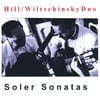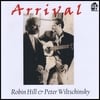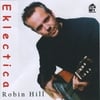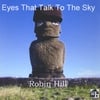Today is a very special post by the man himself - Robin Hill!
It was originally written as a guest blog for the Australian violinist Ben Clapton, back in 2007.
Enjoy!
Music Practice Tips – Classical Guitar
By Robin Hill
When approached by Ben, to write a guest blog spot on ‘practice tips’ for the classical guitar, I wondered where to start.
Having written an entire book, ‘The Guitar Gymnasium, A Mental and Physical Workout, Designed to Develop Flawless Technique,’ published by Mel Bay, it seemed a difficult task to summarise into an article.
Most of my thinking on these matters has been precipitated by the ‘front line’ experiences of concertising, recording, broadcasting and teaching, and a life long passion for the classical guitar, and music in general.
Outstanding performance on any musical instrument can only be achieved through hard and painstaking work. The musician who excels above his colleagues is, generally, the one who has taken more pains.
Regular practice is essential, with technical work of high priority, and whilst students may not want to hear this, there is no escape from scales and arpeggios!
One of the most basic and important principles in guitar technique is economy of movement, not only of both hands, but, of any part of the body involved in the production of the note.
It’s worth investing in a full length, movable, mirror, as I watch myself playing frequently, not out of vanity, but to constantly check positioning and posture.
For practice, I’ll break it down into sections, and start with the arpeggio.
The Arpeggio.
The right hand should remain completely stable with the knuckles immobile and parallel to the strings. The fingers themselves move in a minimal way, pressing, rather than hitting the string.
Initially you can practice this silently by touching the string but without producing any sound.
This helps to establish playing ‘from the string’ and using the minimum amount of movement.
Silent practice should be accompanied by ‘hearing’ the notes mentally, and thus, reinforcing the inner ear.
In fact it is always good practice to ‘hear’ notes in one’s mind a split second before playing them.
Initially the arpeggio should be practiced slowly, gradually increasing the tempo, and the use of a metronome is recommended, but not all the time.
Fluency, technical command and accuracy are paramount.
Variety in practice is important, try to surprise your fingers with new challenges and studies, but always practice attentively. Be aware of the deadly routine of wading, without concentration, through studies and exercises.
The Scale.
There are many different methods of playing scales on the guitar. As a general rule, if alternating between i and m, it is undesirable to cross strings using mi when ascending and im when descending. Whilst not always possible to avoid, it should be seriously considered. So, the guitarist must learn a flexible approach to scale playing, using inventive fingering to avoid undesirable crossings.
It should be remembered, that printed fingering is never sacred, there are usually viable alternatives.
During scale playing the same principles of economy of movement and right and left hand stability apply.
I have also found that practice with the backs of the nails i.e. movement in the opposite direction to the normal stroke, is extremely beneficial. It’s a similar effect to practising rasgueados and leads to improving the right hand’s ‘feel good’ factor.
When practising major and minor scales try playing along with the metronome (on the offbeat) and also using various rhythms.
So regular technical exercises are essential. But one doesn’t need to have an instrument in one’s hands to practise, particularly in the field of memorization.
I personally derive a great deal of benefit from not only ‘playing’ a piece mentally, and hearing the sound and timbre of the notes, but also in imagining a successful concert scenario.
Even when practising with the instrument I feel it is an intellectual rather than a physical exercise.
The temptation to play a piece up to tempo should be resisted, as unless the technical and musical foundations have been laid we will not gain mastery over the music.
The repetition of, ‘hit and miss’ renditions, only serves to ingrain bad habits further.
Difficult passages must be played slowly, with phrasing and musical expression, to prevent the bad habits developing.
One never arrives at the point when one can say, ‘I can now play,’ it’s a lifetimes work for anyone, whoever they are, and one’s ideals are often subtly changing.
I am frequently asked how much practice should be done each day, but it is, of course, quality and not quantity that is paramount.
Generally I practice no more than one hour at a time, but it is a pointless exercise, unless concentration and attention are maintained.
Over an average day I would practise at least five hours, about half the time on technical work, and the other half on musical aspects (learning new repertoire, maintaining established repertoire etc.)
I strongly recommend reading and re-reading every possible tutor and manual on playing and technique. Not just for the guitar, but different instruments, particularly the violin and piano, as there are very often common principles to playing any instrument.
It is impossible to overestimate the importance of going to hear and see as many first class players as possible, of any instrument, as this is one of the most exciting and inspirational ways to learn.
But it is also important not to forget one’s original inspirations and to refer back to them often. They are, after all, the reason you play, and generally, you will still find them inspiring.
Listen and luxuriate in your favourite recordings and let them fuel your enthusiasm. Although there are now many fine players of the guitar worldwide, it is still, unfortunately, rare to get the chance to see and hear them. If you do get the chance, make sure you take it and hear them live, it’s worth a million CDs.
Also play with other musicians. The guitar combines particularly well with the violin, the voice, the flute, the mandolin, the recorder, the oboe and with all manner of small chamber ensembles. This will open you up to the full musical picture and not just ‘your’ part, increasing your appreciation and pleasure on the way.
Much of the information I have discussed today, has come from my book, which also has all the technical exercises, I work through each day.
I will also be going into more detail about practice and performance over on my blog in the next few weeks and months.
But for now, many thanks to Ben for the invitation, and, happy practising!
Reviews
'As always, it was sheer pleasure to observe Robin Hill's remarkable fluent technique: everything looks easy when he plays it.' Colin Cooper- Classical Guitar Magazine -----
'Wonderful for their (Hill & Wiltschinsky) precision, touch and clarity of sound... refined virtuosity, the achievement of a long interpretive process.' Il Giornale D'Italia (Rome) -----
'I loved your CD and thought your technique and performance were fabulous...' Rick Wakeman
Subscribe to:
Post Comments (Atom)


















1 comment:
Great Blog!Whenever I came accross to your blog ,every time I find something new.These are all excellent posts.You have a great blog for music lovers.sala prove milano,also deals in music and vedios.
Post a Comment